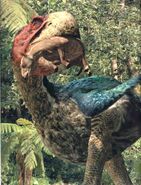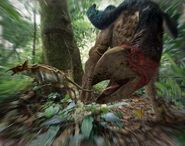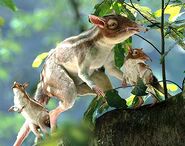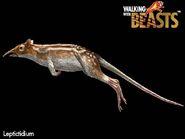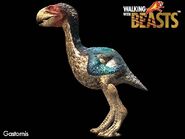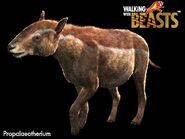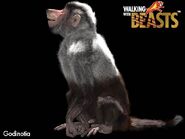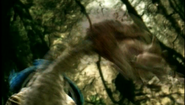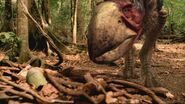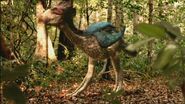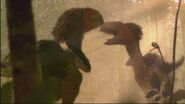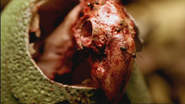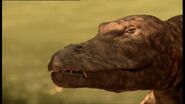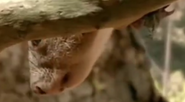| New Dawn | ||||||||||||
|---|---|---|---|---|---|---|---|---|---|---|---|---|

| ||||||||||||
| Previous episode Big Al Uncovered |
Following episode Whale Killer | |||||||||||
New Dawn is the first episode in the Walking with Beasts series. It depicted the Messel pits at the late Paleocene-early Eocene epochs 49 Million years ago. This episode deals with the beginning of the Cenozoic and the beginning of mammal evolution, as mammals struggle to survive alongside such early menaces as giant flightless birds and insects.
Episode synopsis
The episode starts by showing how the dinosaurs were dominating the land and that mammals were small. Then it shows how "an asteroid the size of Mount Everest" struck the Earth and demolished the dinosaurs, and how mammals evolved into new forms thereafter. The first episode depicts the warm tropical world of the early Eocene, sixteen million years after the extinction of the non-avian dinosaurs. Birds, the surviving lineage of the dinosaurs, including the giant carnivorous Gastornis, rule this world, while mammals are still very small. The setting is near the Messel pit in Germany. Due to volcanic activity, sudden bulk escapes of carbon dioxide trapped underneath lakes pose a significant hazard to the local wildlife. The episode centers around a Leptictidium family, a leaping, shrew-like mammal, which has emerged in the dawn hours to forage for food. As the mother Leptictidium forages, first in solidarity, and then with her pups, she wanders near a large predatory mammal, identified as an Ambulocetus, a "walking whale". Despite its crocodilian similarity, the Ambulocetus is shown swimming by caudal undulation like a modern cetacean. A female Gastornis, who has been taking care of the single egg in her nest, makes two attempts to hunt a small herd of Propalaeotherium, early horses. The first attempt fails when sounds among the vegetation betray her presence. The second attack proves successful when the Propalaeotherium consume fermenting grapes and are unable to evade her attack. The Gastornis also defends her territory from another Gastornis. Unfortunately, while the mother hunts, a horde of Titanomyrma, giant carnivorous ants, encounter the egg when it was just starting to hatch, and successfully kill and eat the chick. When the female discovers her dead offspring at dusk she leaves the forest to try and start another family.
With the arrival of night, a band of lemur-like Godinotia, socialize and copulate in the dark. Ambulocetus finally manages to catch a Creodont near the lake edge. As the night wears on, an earth tremor unleashes trapped carbon dioxide out from underneath the lake and the gas suffocates most of the surrounding life. The Leptictidium survive because the nest was upwind of the gas, and Gastornis also survived because she left that area in the forest.
It is mentioned that although the Leptictidium survived the gas, they would ultimately leave no descendants, while the Ambulocetus, who was killed by the lethal gases, would evolve into the whales, hereby setting the scene for the next episode.
Creatures
65 Million Years Ago (Montana, USA)
- Ankylosaurus
- Tyrannosaurus
- Didelphodon
- Gypsonictops
- Meniscoessus (live acted by Squirrel)
49 Million Years Ago (Frankfurt, Germany)
- Propalaeotherium
- Leptictidium
- Gastornis
- Tree frog (live acted)
- Dragonfly (live acted)
- Godinotia
- Eurotamandua (live acted by Northern Tamandua)
- Ambulocetus
- Titanomyrma (identified as Giant Ants)
- Creodont
Trivia
- The space view shot of the comet impact is reused in a re-release of Death of a Dynasty.
Gallery
Promotional Images
Episode Screenshots
Broadcast
Original airdate
- 15 November 2001 20.30 BBC One
Repeats
- 18 November 2001 16.30 BBC One
- 19 February 2003 19.00 BBC Four
- 25 November 2006 20.00 BBC Three
http://genome.ch.bbc.co.uk/search/0/20?adv=1&order=asc&q=Walking+with+beasts&media=tv&yf=1999#search

